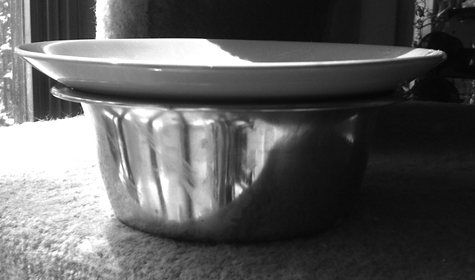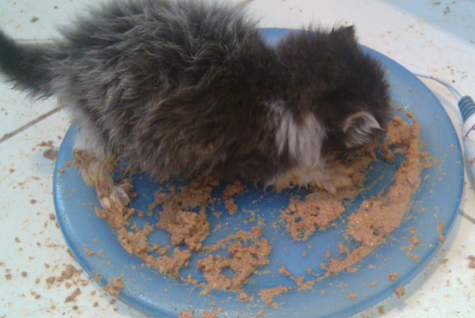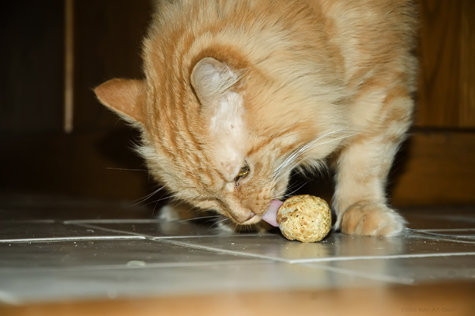
You are here
The Finicky Feilne: Tips for Getting Fluffy to Eat
Getting a cat to eat their food can be one of the most challenging aspects to cat care, especially if you're trying to transition your cat to a more species appropriate diet. Getting a cat “off the grain” is not easy. Pet food manufacturers did a great job figuring out what to coat their dry, grained kibble in to make cats want to devour it. The problem, those grained, dry diets have the least amount of appropriate nutrition.
Do you see your cat GULP their food down, then throw it up not long after they eat? It still looks the same going in as it does coming out? That's a sure sign you need to change your cat's diet. If your cat suffers from just about any medical issue, especially skin allergies, digestive issues, even recurring ear infections and many others, it's time to change the diet.
Today's post is about tricks for transition, over what exactly to feed your cat (which I'll write about at another time). Bottom line-feed them grain-free. No wheat, soy, corn, oats, rice. Obligate carnivores don't have enzymes in their saliva to break down grain, therefore, whatever grain is in their food, basically passes through their body, elevates their blood sugar to a point of causing diabetes in some cats and comes out as a very stinky poop. So why feed that to your cat?
These tips are for EVERY cat owner, even if they're already feeding a great diet to their cat. Once in awhile your cat will walk away from their food. It's annoying, can cost money in wasted food and it's obviously not good for your cat.

I use a cheap metal bowl to elevate my cat's food plate. Fits perfectly!
1. Elevate your cat's food dish (and water bowl!). If you observe your cat eating, they really have to tip their head down to eat off a dish on the floor. By placing the dish onto a book, a bowl, or buy an elevated dish set up from a pet shop, you ease the strain on the cat's throat and back. If they can eat more comfortably, they're spend more time at the plate.
2. Paper but not PLASTIC! Feed your cat on a CLEAN china plate, glass dish, or paper (if it's new every day). Do NOT USE PLASTIC OR MELAMINE. These plates cannot really be cleaned of microbes because the surface is soft and gets scratched. Those scratches contain the bacteria that causes problems and your cat can get feline acne.
3. I prefer feeding off a small, about 6 7/8" plate. I don't like bowls because the cats whiskers can get crammed into the bowl while they eat. That cannot be comfortable for them. Make sure the opening is wide if you do feed out of a bowl.
4. Each cat gets their OWN plate. No lumping all the food together so your cats have to compete for their food. Give them each their own plate, their own PLACE in the home, to eat. Give them SPACE from each other so they can eat in peace. This way you can monitor who is eating and who is not. Also, try to have quiet time during feeding. This helps the cat relax while eating so they can enjoy their food instead of gulping it down.

©2010 Maria S. Polly Picklepuss shows us how not to feed the cat.
5. Canned food feeding tips:
- Warm SLIGHTLY in the microwave. This enhances the smell. Cats go by SMELL. The stinkier, the better.
- I am the Queen of “Sprinkles.” I find that some times I need to sprinkle a bit of something else on top of the food to get the cats started eating. It's like trying to start an old lawnmower. You have to keep trying to get it started, but once it's going, it runs fine.
-SPRINKLES: Bonito Flakes or Bonito Sprinkles, Whole Life Freeze Dried Treats, Dinner Party, Parmesean Cheese (really!), Stella & Chewy's Dehydrated Raw Crumbled on top.
What do you do if your cat STILL won't eat?
Is your cat SICK? Does he or she have an upper respiratory infection, allergies, a nasal polyp? These are just some of the reasons why your cat may have lost their sense of smell.
Your cat could be sick with just about anything else, too. Cancer, kidney disease, liver disease, there are so many reasons why a cat is tough to feed that if it becomes a chronic issue, you really need to get your cat checked out by a Vet.
If your cat IS sick and you know they're tough to feed, like my boy, Bob Dole, then there is more you can do. Bob is VERY tough to get to eat. The lymphoma he battles absorbs his nutrition before it can go to anything else. Bob gets sick from chemo and his liver is failing, but it doesn't stop me from trying to get him to eat SOMETHING.
For senior cats whose sense of smell is diminished or for cats like Bob you can try to mix some PLAIN (no rice) Chicken Baby food into their canned food. Baby food, alone, does not have enough in it to be a complete diet for a cat, so you MUST feed it with other foods OR just feed it for a few DAYS. Warm the baby food in the microwave. Make sure it is NOT BOILING HOT. Just a bit warmer so the aroma is obvious.

©2006 Robin A.F. Olson. Bob Dole and the frozen turkey meatball in 2006.
I'm not a big fan of these, but there ARE some high calorie vet-only canned foods like A/D and Iam's Max Calorie. These are really only for getting the cat to eat for a short time or to syringe feed (force feed) your cat to eat. They can really be a lifesaver as they are smooth and easy to syringe into your cat's mouth. I have to do that with Bob from time to time to make SURE he's eating. These foods are often used after surgery or in critical situations, not day-to-day feeding.
Another trick-CLAM JUICE. Yep, it's cheap, easy to get at the grocery store and can STINK UP the food, quick. Make SURE THERE IS NO MSG in the clam juice AND watch the sodium. This is a very salty additive so use it sparingly. If you add it to food, warm it up together and it can really do the trick. I had to hide tiny anti-seizure pills in my cat, Sasha's food and I put it in some clam juice and she lapped it right up.
Maybe it's just the food?
That's true, too. If they just don't like it, change it. I just learned this a few months ago and is VERY important:
Feed your cat, if you feed canned, a variety of brands and flavors of cat food, NOT JUST ONE BRAND, ONE FLAVOR.
Firstly, like people, cats need some variety, but more importantly, each company has a different method of preparing their food, they use different ingredients or the source of those ingredients and the quality of those ingredients are different. If your cat only ate chicken, it might get to a point where it cannot digest anything else. Chicken has certain vitamins and minerals that, say, beef does not, but beef has something that chicken does not and so on...so feeding a variety can help your cat truly get a balanced diet and they may enjoy the discovery of “what's for supper?” each day. It also allows their digestion to be more able to handle whatever the cat is fed and may reduce the cat's issues being finicky.
Lastly, pet your cat. Scratch him or her behind their head, on their neck. It mimics when their mama would groom them as they were being nursed as kittens. Some times that little bit of comfort can get the cat to eat, too.
After all this, if your cat STILL won't eat, make SURE you take them to the Vet for a checkup. A simple thing, like a cracked tooth or dental decay can put a cat off their food and make eating painful.
Good luck and let me know if this helps you with your finicky feline!
©2011 Robin A.F. Olson.


















Comments
Heating up that food
I personally don't like to use a microwave oven because I'm concerned that the "zapping" process may somehow change the chemical makeup of the food. I don't have any science to stand by that, it's just a gut feeling. Anyway, what that boils down to is, I don't have a microwave.
However, I do think heating up a cat's food -- especially raw food -- is very helpful in getting the cats to eat it. The way I heat up raw food is to use a double-boiler type setup, without the boiling. I put very hot water from the tap into a pot, and then I put the right amount of raw food into a stainless steel dish, which then sits, with a cover on top, in the hot water. I let it sit for about five minutes, which warms it up to something like mouse body temperature, then stir it around to even out the temperature and serve it to my cats in their own dishes.
Some people might freak out about bacteria growth, but I think that a) five minutes isn't going to cause massive bacterial buildup; b) even if there was some minor bacteria growth, healthy cats' stomachs and digestive systems could tolerate it; and c) they're much less likely to refuse the food or throw it up if it's not refrigerator-cold when they eat it.
Thanks for another great
Thanks for another great article! For my Casey-cat (who has CRF and therefore often feels too nauseated to want to eat), I'll put a little dollop of bacon grease, tuna oil/water, sardine oil/water, or chicken water on her food. That generally gets her to start eating, and once she starts, she'll usually keep going for a while. I'm not sure if those additives are good for her, but I'm at the "whatever works" stage. Non-liquid toppings she just eats off the food, then walks away and leaves the food there - and if I've put medicine if the food, that's super-frustrating!
eating tips
I've tried most of what you've suggested. I also have used sliced turkey and chicken when cat food isn't enticing enough. Also, low or no sodium chicken broth. Even when a cat won't eat, they will usually drink. The broth gives them fluids along with some nutrition. Unless it's nearly hopeless, once they eat something, they seem to regain their appetite. And I definitely keep A/D on hand. Nothing better for force feeding. I use one of those syringes used to irrigate wounds/abscesses the has a curved tip. I just snip off a bit of the end to enlarge the hole. It makes it much easier to get into the cat's mouth.
Add new comment